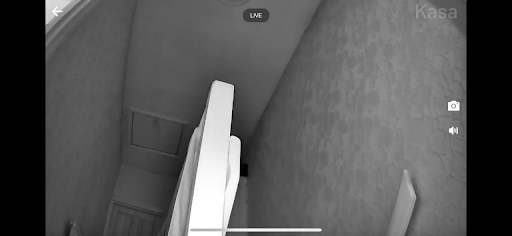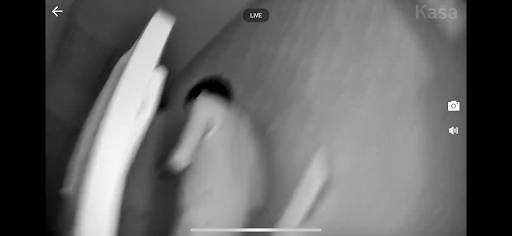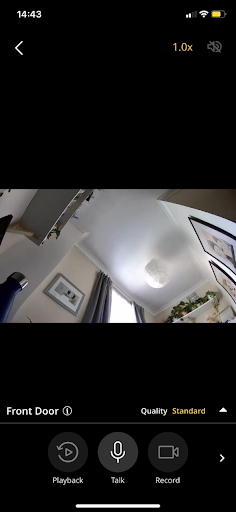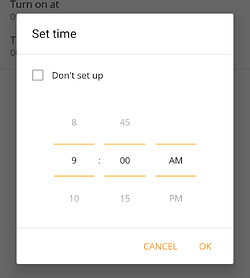Whether it is consumer-grade or commercial, only the best security camera provides peace of mind. Unfortunately, choosing the best video surveillance system for the home or office can be daunting because of the wide selection available.
Picking the best one for your needs is easier when you know what features to look for when buying a security camera. Read on to find out which features you should be prioritizing when investing in a security camera.
Bonus: With AlfredCamera, you can easily transform your spare phones into free security cameras with almost all of the features discussed below. Try it out today on iOS and Android devices.
Features to Look for in a Security Camera
Security cameras vary in features, materials, technologies, and overall design. Some cameras are so small and discreet that you won’t even know there’s a camera watching your every move.
Some activate the camera only when it senses movement, while others offer a detailed image even when it’s nighttime. So, what features should you look for in a security camera? Let’s find out.
Night Vision
Video surveillance systems must work round-the-clock, including in low-light conditions, to safeguard any property. It makes no sense if the security camera stops working simply because the area within the device’s field of vision is dark. A security camera with night vision capabilities is a must in such instances.

What does night vision do?
Night vision technology allows the security camera to “see” in dark or low-light conditions. This camera lets you observe your property’s surroundings at night or when the room light is off and record any event that might warrant your attention.
Night vision cameras feature one of two technologies. Most security cameras have infrared sensor technology that captures reflected infrared light from objects.
On the other hand, some night vision camera systems offer software-based low-light filter technology to produce recognizable images in the dark. These security cameras use image intensifiers to convert red-green-blue (RGB) picture data into luminance- and chrominance-based color information.
Why is it important?
Night vision security cameras are necessary for safeguarding your property at night and in low-light conditions, especially outside the home.
This technology is also essential for vehicle owners, especially when parking outdoors. Keeping the cabin light on is impractical because it can drain the car battery. Installing a night vision camera in view of the driveway is a much more logical solution for protecting your vehicle.
Leaving your baby in the crib at night might be unsafe while you’re sleeping in another room. Night vision cameras allow you to “observe” your infant even in the dark or with only a night lamp illuminating the nursery.
Think a night vision camera is right for you? You can check out our picks.
Motion Detection
Recording events non-stop drains the security camera’s battery faster and increases electricity consumption. It will also eat up the device’s storage. Hence, motion detection technology is a must for any security camera.


What does motion detection do?
As the name implies, motion detection allows the security camera to record what it “sees” only when it senses movement within its field of vision. These usually rely on passive infrared technology to detect heat from people, animals, and anything else in the frame.
A rapid or sudden rise in detected heat triggers the security camera to start recording. Some systems connect to a linked mobile device, allowing you to view the event via live stream. Some security cameras have two-way audio (find out more below), enabling you to communicate instantly with whoever the security camera detected.
Why is it important?
Motion detection ensures more efficient use of the security camera’s memory and storage by eliminating hours of unusable video. It only records events when the system detects movement, therefore also improving battery life and eliminating the need for frequent battery replacement or charging.
Interested in seeing how motion detection cameras can work for you? Find out more.
Continuous Recording
Closed-circuit television (CCTV) cameras record events round-the-clock unless there’s a power outage. That’s why most systems have emergency power sources to keep the device running in the event of an outage.
Security cameras that work on Internet Protocol (IP cameras), on the other, do not only contend with power outages. These devices’ performance can also take a drastic hit if the internet signal is unstable.



What does continuous recording do?
Continuous recording is a feature you want to look for in a security camera if you know your internet is a little temperamental. Continuous recording allows the security camera to record events nonstop even when the camera is offline.
Unlike motion detection technology that only activates the camera when it senses movement, a video system with continuous recording is perfect for monitoring high-traffic areas and in instances when the property owner wants to see everything the lens sees.
Why is it important?
Although the above mentioned issue won’t affect everyone, a ten-member household sharing a single wireless internet hub, for example, would struggle greatly to maintain a functional connection.
Which security cameras support continuous recording? Find out more.
Two-Way Audio
It’s one thing to see people wandering near your property. It’s different if you could communicate with that person at your door. With two-way audio, you could talk to the delivery person knocking at your door, even if you were on the other side of the globe.
What does two-way audio do?
A security camera with two-way audio lets you communicate with whoever is on the lens’ other side. You’ll use your smartphone or other mobile device to talk to the person, and they will hear you through the camera’s built-in speaker. The person can then speak to you using the security camera’s integrated microphone.
Why is it important?
Much like using a walkie-talkie, two-way audio gives you the advantage of hearing and seeing who you’re talking to. On that note, some homeowners love using this feature to communicate with their pets just as much as they do dealing with delivery people and unwanted visitors.
Discover the ways two-way audio can improve your security and pet-monitoring.
Siren
One issue with conventional security cameras is that they are “passive.” A home intruder can go through your belongings uninterrupted. Although a security camera records the event to help law enforcers catch the bad guy, it cannot always scare the criminal away.
What does Siren do?
Picking a security camera with an alarm or siren function can be used to ward off would-be intruders. This technology allows you to trigger the device to emit an ear-piercing noise to scare criminals, who, in the case of property crimes, are usually just opportunists looking for the easiest target.
Why is it important?
Even with a camera, an intruder might believe that no one is occupying a home without extensive warning signs. If your camera also has motion detection capability, you can view the “event” to check if it’s necessary to activate the siren. Even if the siren doesn’t scare off the criminal immediately, the loud noise should alert neighbors, who can then contact authorities.
Not all cameras have sirens, but the AlfredCamera app turns your old phone into a security camera with good loud siren.
Video Storage
You have two options when it comes to a security camera’s video storage. The first is local storage, which are perfect if you have privacy concerns. Most products with local storage capabilities accept MicroSD cards from 16GB to 2TB. You can remove the MicroSD from your security camera and transfer the video files to your computer if it’s full. SD cards are usually necessary for continuous recording.
Your second option is cloud-based storage. The security camera records videos, transmits them to remote servers via the internet, and stores them in cyberspace, freeing you from the hassle of local storage. Access to remote servers isn’t free, and most companies charge a monthly subscription.
Why is it important?
If you want convenience, go for a security camera with cloud storage. Devices with local storage, on the other hand, are well-suited to people who would prefer continuous recording over motion detected events. Or, you could get a security camera with MicroSD and cloud storage for the best of both worlds.
Find cameras with subscription-free storage with our dedicated guide. In addition, even the free version of the AlfredCamera app provides 7 days of free storage.
Advanced Features You May Also Want
Night vision, motion detection, continuous recording, two-way audio, siren, and video storage solutions are all crucial considerations when shopping for a security camera. But that isn’t all there is to a modern day security camera.
Check out some of our favorite advanced features below if you’re looking for a camera that goes the extra mile.
Motion Detection Zone
One issue with conventional motion detection is that it is prone to triggering false alarms without intelligent AI. You might receive notifications every few seconds because of irrelevant movements, light reflection, or tree movements. This can be dealt with by enabling a motion detection zone feature.

The motion detection zone is an innovative software that allows you to define areas in the frame that will trigger a recording if there’s any movement within it, while ignoring activity outside of it.
Learn more about AlfredCamera’s Motion Detection Zone feature.
Motion Detection Schedule
Most homeowners want the ability to control a security camera’s motion detection feature, especially its activation and deactivation. For example, some days you will want continuous recording, while at other times, motion detection might be preferable. A security camera with a motion detection schedule is perfect for the job.

This feature lets you set your security camera to activate or deactivate its motion detection sensor at predetermined times. For example, you can turn on motion detection at night (i.e., from 8 PM to 7 AM the following day) to conserve power and eliminate unnecessary storage hogs.
Learn more about AlfredCamera’s Motion Detection Schedule feature.
AI Facial Recognition
Advanced machine learning models and artificial intelligence (AI) allow some security cameras to identify the people they “see” through the lens.
Some brands integrate this technology to activate the security camera only when it identifies human action.This is a really handy feature for pet owners, as it avoids the constant false alarms caused by furry friends with a case of the zoomies.
Learn more about AlfredCamera’s AI Person Detection feature.
Pan-Tilt-Zoom
A live feature, pan-tilt-zoom enables you to control the security camera’s live feed. This technology lets you shrink or enlarge the frame and move the camera side-to-side and up and down. You don’t have to be physically present at the security camera’s location because you can perform these actions remotely.
If you’re keen to find a camera that has motorized movement, check out our overview of TP-LInk’s Kasa Spot camera, a brilliant, budget-friendly security solution based around a robust pan-tilt-zoom feature.
Learn more about AlfredCamera’s Zoom feature.
Emergency Connectivity
Some security cameras feature an emergency button that users can activate to connect to a service that dispatches medical emergency, fire, or police services to their registered address.
For example, if you receive a notification from the security camera and want immediate professional action, pressing the emergency button prompts the service provider to contact the appropriate 911 services. These always require additional fees, which are usually paid annually.
Conclusion
Security cameras vary in features, with some that’ll be far less necessary for your needs than others. That’s why a strong understanding of your needs and preferences is important when deciding on the best device for you. Although a security camera with standard and advanced features is ideal, everything depends on your requirements, which will also be impacted by budget.
The AflredCamera app serves as a great way to get started. By turning your old phone into a fully-functioning security camera packed with plenty of the features discussed above, you can begin to take your home, vehicle, pet, and baby surveillance concerns into your own hands. Did we mention that you can do all that for free?
Try it out today on iOS and Android devices.
Recommended reading: Types of Security Cameras: The Essential Guide
